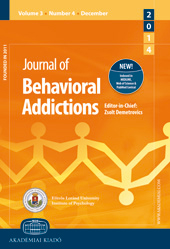Author(s): Ina M. Koning,Margot Peeters,Catrin Finkenauer,Regina van den Eijnden / Language(s): English
Issue: 3/2018
Introduction. This two-wave prospective study investigated the bidirectional relation between Internet-specific parenting (reactive restrictions, Internet-specific rules, and frequency and quality of communication about Internet) and adolescents’ symptoms of social media disorder (SMD) and Internet gaming disorder (IGD). In addition, we investigated whether this relation was different for boys and girls.
Methods. A sample of 352 adolescents (48.9% boys, Mage = 13.9, SDage = 0.74, range: 11–15) completed questionnaires at two waves. Zero-inflated cross-lagged analyses in Mplus were performed to predict the level of IGD and SMD symptoms by Internet-specific parenting practices and vice versa, while controlling for age, level of education, and outcome at T1. Results. More frequent parent–adolescent communication about Internet predicted more IGD (β = 0.26, p = .03) and SMD symptoms among boys, and more restrictive rules predicted fewer SMD symptoms among girls (β = −0.23, p = .08). More IGD symptoms predicted more reactive rules (β = 0.20, p = .08) among boys and girls and a higher frequency (β = 0.16, p = .02) and lower quality of communication (β = −0.24, p < .001) among boys and girls, respectively.
Conclusions. This study demonstrates bidirectional relations between Internet-specific parenting and IGD symptoms, but not SMD symptoms. Displaying IGD symptoms seems to elicit ineffective parental responses, which may further exacerbate problematic involvement in gaming. With respect to problematic social use media among girls, this study suggests that parents should set strict rules regarding Internet use, prior to problematic use of social media. Longitudinal studies on the role of parenting in development of Internet-related disorders would be promising in enhancing our understanding of how parents can effectively prevent problematic involvement in online behaviors among their children.
More...


